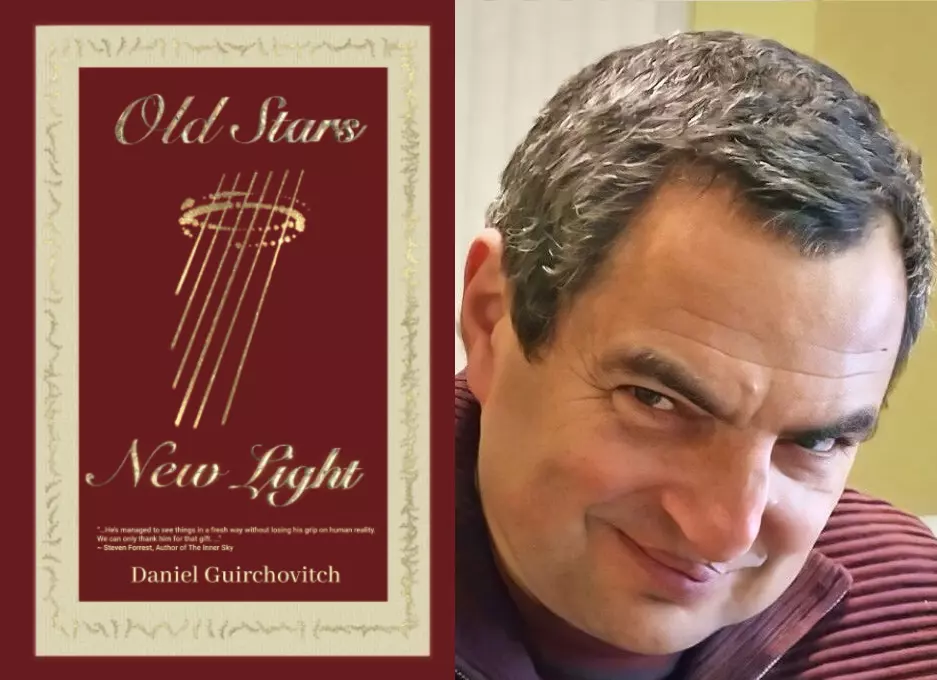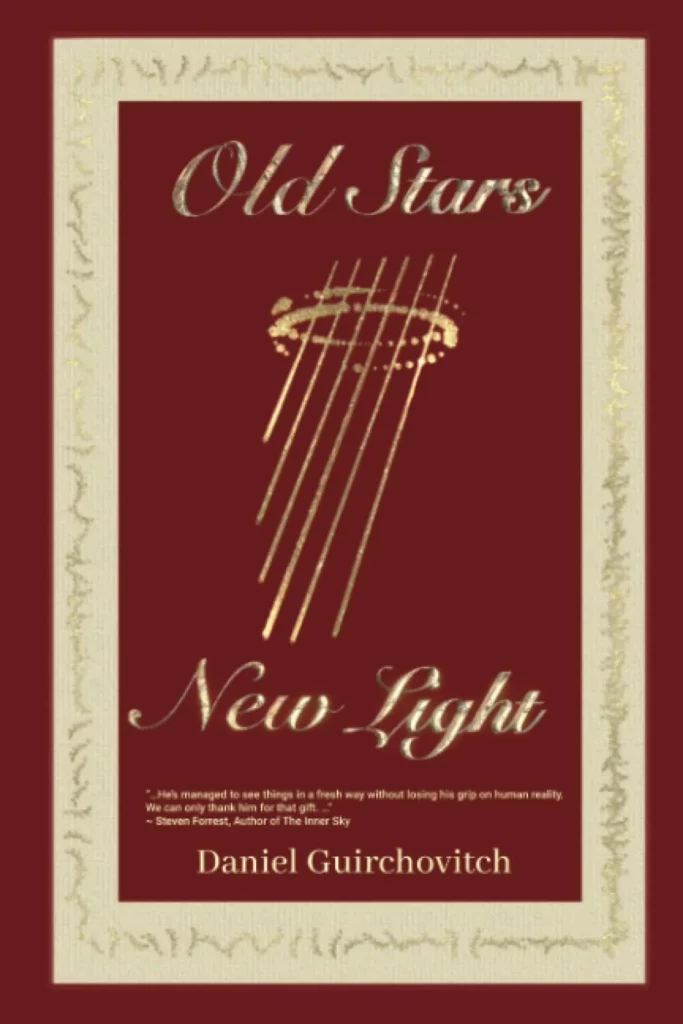This post may contain affiliate links. Read more here.

Hey everyone!
Today I had an amazing interview with Daniel Guirchovitch, the author of Old Stars, New Light. In our conversation we discussed his unique journey into astrology, the profound lessons from his mentor Elias, Tarot, and runes, and how these divinatory systems influenced his writing.
For my review of Old Stars, New Light, click here.
I hope you’ll enjoy our conversation! ✨
Old Stars, New Light by Daniel Guirchovitch
Your book, “Old Stars, New Light,” offers a unique blend of astrology, Tarot, and runes. What inspired you to explore these interconnected divinatory systems in your writing, and how did you decide to integrate them into a single work?
Thank you, for your wonderful kind review of my book and this opportunity to chat.
I have been reading charts for friends and clients since high school. This is one of my ways to make sense of life, to know myself and connect to others. The Tarot and runes came later, when I was gathering information for the book. A friend of mine inspired me to look into these modalities and I realized they are complimentary to astrology.
See, astrology is a divination art – it can be very rigorous, even scientific, but during the reading some kind of magic happens and two people begin to explore the possibilities – why we do what we do, our personality, challenges and talents, and how we may use them to our benefit. Cards and runes explore these same topics in different ways – using imagery to guide intuition. Since I added these tools I became a better, more fluent astrologer.
Could you share a bit about your journey into astrology and how it has evolved over the years? What role did mentors like Elias play in shaping your approach to this ancient art?
I was interested in astrology since my teen years – it offered me a model of the universe, a “source code” of life and people in it, and a language to talk about these things. I had several good teachers including foundations by Alexander Kamensky, lessons with Anthony Picco, extensive study of Steven Forrest‘s style of evolutionary astrology.
But it was Elias that really helped me to reevaluate the core meaning of astrological vocabulary, chart delineation and putting it all together. Elias offered perspectives so different that I had to revise my approach to readings and design my own framework.
Your book features in-depth discussions with your mentor, Elias, spanning nearly a decade. Can you tell us about the most profound or transformative insight you gained from these dialogues during the writing process?
Every conversation had some delightful pearls in it. From approaching the archetypes in astrological signs based on deep study of symbols, to redefining the nature and meanings of individual astrological houses and planets.
The animals in the zodiac – Goat, Bull, Crab, Lion – these discussions were fascinating “National Geographic specials”. We dived into lives and designs of these creatures and how it maps to people of corresponding signs.
Different understanding of houses, their calculation (house systems) and interplay. Revolutionary take on declination – an underrated part of astrology.
Redefining numerology in tarot and discovering radically different meaning of some cards. Putting runes in their fascinating historical context as divination tools, rune casting.
Many readers find astrology fascinating but also complex. How do you approach making astrological concepts accessible to both beginners and experienced practitioners in your book?
For every element – each sign, house, planet (point) and aspect – I asked Elias to suggest the keyword that best describes the essence of it. We discussed how these keywords relate to traditional interpretations and how to put it all together. I believe that we achieved greater clarity and simplicity in the process.
There is a two hour sample chart reading included, thanks to Jean Lamb courageously offering her chart to be read publicly. There are also many specific interpretations that are present throughout the book, and that hopefully demonstrate how I was learning to simplify the approach to astrology.
In your book, you mentioned your nickname, “the Soother,” due to your inclination to encourage and support others. How does this nurturing quality manifest in your astrological consultations and divinatory readings for clients?
I was hesitant to include that “Soother” name in the introduction, because it almost sounds like bragging. But it’s true – some of my friends used this, sometimes in jest, to tell me my instinct and my talent is to see the situation in most favorable light and to seek solutions to make it better.
Perception is a very powerful tool, we can limit ourselves by it or we can widen our view. In fact in the book Elias uses perception as not only the way we see the world but also the way we express ourselves in it. In a manner of speaking perception is how we create our lives, moment by moment. I use astrology to identify the connections between the chart and what e are creating, and to make sense of it.
I believe many people, once they see the meaning in what is occurring, tend to accept the situation more readily and to move towards the solution. That is perhaps how the soothing approach works.
You’ve had a diverse career, from applied mathematics to film directing to software solutions architecture. How do these diverse experiences influence your perspective on astrology, Tarot, and runes, and how do they complement each other?
I am realizing more and more how connected, or interconnected, everything is. Software architecture and design are easily relatable to figuring out the functioning of a birth chart – both involve modeling real life behaviors, seeing things as diagrams, maps or charts, puzzle solving, design patterns.
Films also have an architecture or design – form, structure, flow. Making films strongly relies on using one’s imagination and intuition, as do all forms of divination. In films we go from plot to images, in Tarot – from images to plot, but in either case it is an iterative process and a two-way street. Images can move a film director, writer or actor to modify the story or enhance the dialogue.
Similarly context of a reading – the question, conversation with the client, etc can help the reader to interpret the imagery on the cards, chart or runes correctly.
Could you describe your writing routine and process for “Old Stars, New Light”? Do you have any specific rituals or habits that help you tap into the creative flow when working on a project like this?
As Jean Lamb transcribed the session recordings, we’d proofread it and make changes. Then I worked with Joyce Foxcroft to improve the text.
My role was to shorten my side of the dialogue and make it more streamlined and informative, without changing the nature of my questions. Joyce would make it flow smoothly- improve the phrasing, grammar, make it adhere to the standards we have designed. It was an iterative process – as I read Joyce edits I was often inspired to edit further and send it to Joyce for final edit.
When the editing was done, I really wanted each chapter to be introduced by a drawing to make it more memorable and more fun to read. This is where my wife, Natasha Vsevolodskaya, came to my rescue and produced a set of wonderful illustrations as well as fantastic design of the book cover. We’d take a chapter, discuss the topics and how to express them in a drawing, then Natasha would do her magic and illustrate.
I’m in awe of how she did it, especially since this is her first project as a book illustrator ever. You can see some of her drawings on my site.
I often did my part on the train, while commuting to work, or during music rehearsals Natasha conducted at our house – it helped me focus and get out of my own way.
Throughout your book, you emphasize the idea that “everything is connected.” How has this belief in interconnectedness shaped your approach to astrology and divination, and how can readers apply this concept to their own lives?
As an example , making morning coffee in my kitchen can be done with attention and awareness, or automatically. I can rush thru it, even be irritated, or I can enjoy making it and feel an appreciation for all the labor that went into the beans, the aroma, the flavor of it. The same energy ripples out to the rest of my day.
If I were present and appreciative, that sets my mood and attitude such that I may flow better in office, with my colleagues, design decisions, etc. I have a tendency to dismiss “little” things like that, but the energy is the same as making “big decisions“. And since we are in the kitchen making “small choices” much more often than making life altering decisions, it is more efficient to start small.
It’s easy to see how relationship issues affect our performance at work, or wise versa. But any choices, however minute, affect every aspect of our life, whether we realize it or not.
So in readings I often suggest small experiments first, so our approaches can be tested, not unlike proof of concept in software development.
As an author, what message or insights do you hope readers will take away from “Old Stars, New Light,” and how do you envision it impacting their understanding of themselves and the world around them?
I wish the readers see astrology, tarot and runes as fun tools to understand ourselves and our loved ones. That they use it to navigate their lives. And most importantly that they have fun – fun reading, fun trying out the tools, fun experimenting.
Some of my friends read the book by opening it in random places to see what resonates, and continue reading when their interest is hooked. Some read with their birth chart at hand. Some pull cards or cast runes and use the book as reference.
Regardless, I hope the book helps them the way it helped me, better yet in whichever way suited them best.
Finally, what’s next for Daniel Guirchovitch? Do you have any future projects or writing endeavors on the horizon that you’d like to share with your readers?
I am busy promoting book and doing work for clients. After the book has been released I got more clients, several interviews, was invited as a guest speaker to some study groups. So I am just enjoying the ride and making sure I trust the book to succeed.
I also plan to write more books – perhaps continue the astrology-based fantasy I started years ago, write a memoir, or do something I can’t even imagine at the moment.
The Old Stars, New Light book keeps on giving, and I’m enjoying every gift, as a child on their birthday.
For more with Daniel, make sure to check out his website!
Happy reading! ❤️
